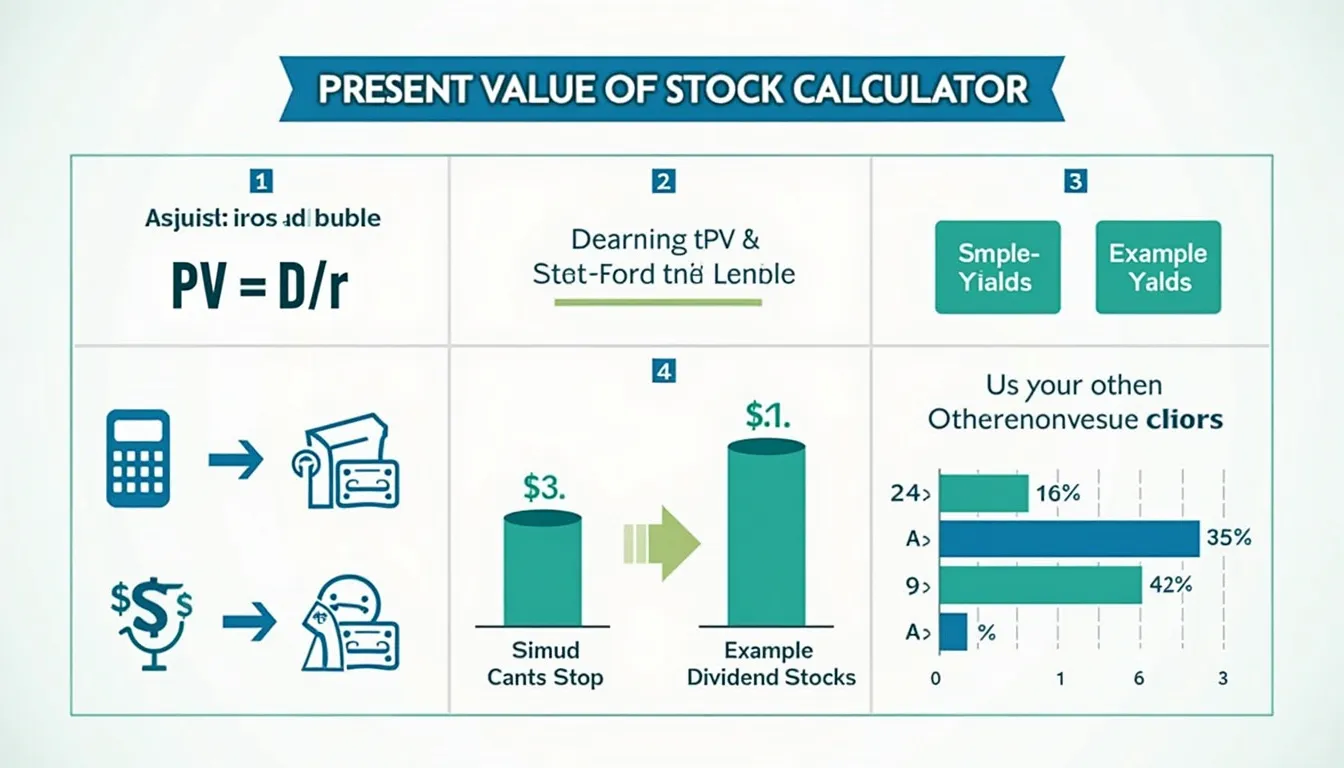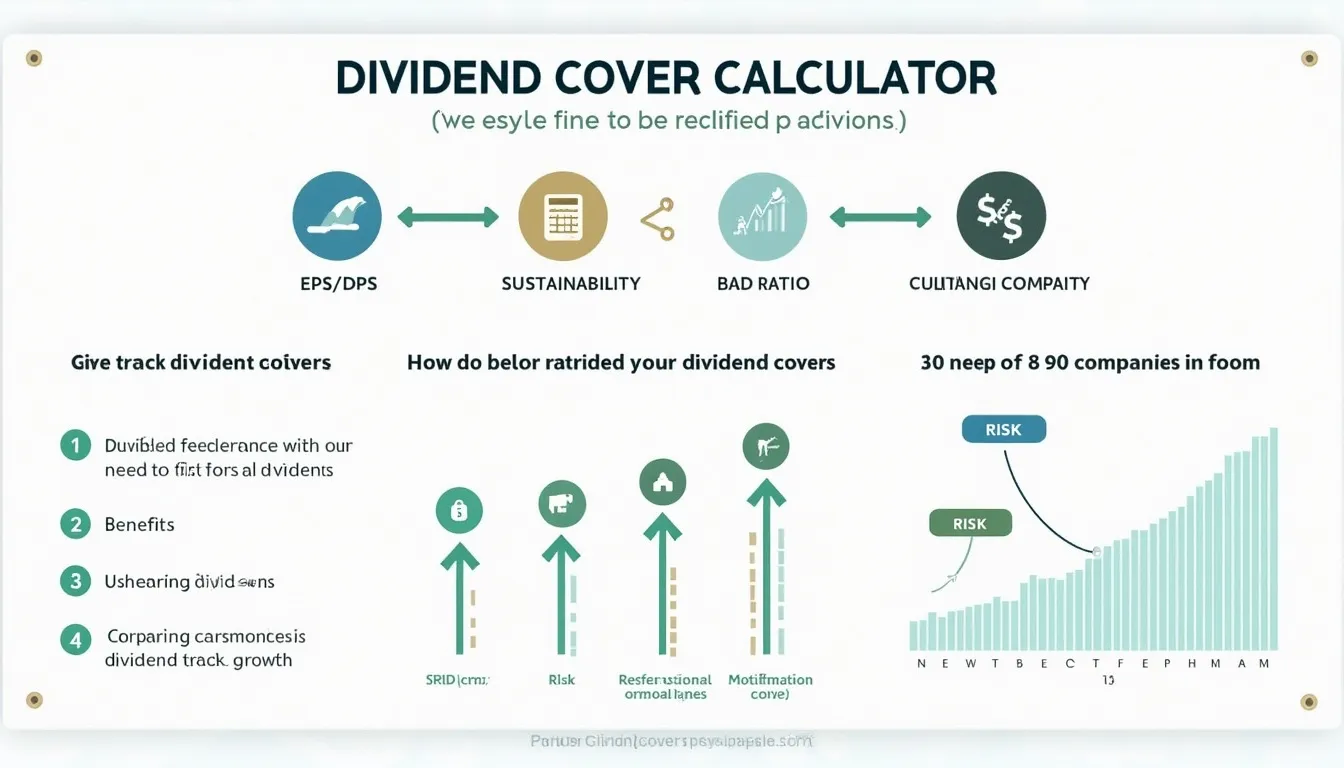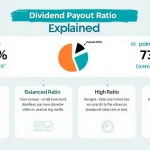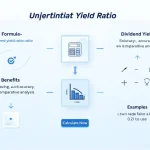Present Value of Stock Calculator
Is this tool helpful?
Welcome to our comprehensive guide on the Present Value of Stock Calculator, a powerful tool designed to help investors, financial analysts, and students accurately determine the intrinsic value of stocks with zero growth. This calculator simplifies the complex process of stock valuation, providing you with instant, reliable results to inform your investment decisions.
How to Use the Present Value of Stock Calculator Effectively
Our user-friendly calculator is designed for ease of use, allowing you to quickly obtain the present value of a stock with zero growth. Follow these simple steps to get started:
- Enter the expected dividends per period in USD in the “Dividends Per Period ($)” field.
- Input the required rate of return as a percentage in the “Required Rate of Return (%)” field.
- Click the “Calculate” button to generate your result.
- View the calculated present value of the stock displayed in the result section.
The calculator automatically saves your inputs, making it convenient for you to return and adjust your calculations as needed.
Understanding the Present Value of Stock with Zero Growth
The present value of a stock with zero growth is a fundamental concept in finance and investment analysis. It represents the current worth of a stock based on its expected future dividend payments, assuming these dividends will remain constant over time. This valuation method is particularly useful for mature companies with stable dividend policies and limited growth prospects.
The Mathematical Formula
The formula used in our calculator to determine the present value of a stock with zero growth is:
$$ PV = \frac{D}{r} $$Where:
- PV = Present Value of the Stock
- D = Dividends Per Period
- r = Required Rate of Return (expressed as a decimal)
This formula, also known as the Gordon Growth Model with zero growth, provides a straightforward way to value stocks that are expected to maintain a constant dividend payout.
Benefits of Using the Present Value of Stock Calculator
Our calculator offers numerous advantages for investors, financial professionals, and students alike:
- Time-Saving: Instantly compute complex stock valuations without manual calculations.
- Accuracy: Minimize human error and ensure precise results every time.
- User-Friendly: An intuitive interface makes it accessible for users of all experience levels.
- Educational Tool: Ideal for students learning about stock valuation and financial modeling.
- Decision Support: Aids in making informed investment decisions based on quantitative analysis.
- Scenario Analysis: Easily adjust inputs to explore different valuation scenarios.
- Mobile-Friendly: Access the calculator on-the-go from any device with an internet connection.
Addressing User Needs and Solving Specific Problems
Our Present Value of Stock Calculator addresses several key challenges faced by investors and financial analysts:
1. Simplifying Complex Calculations
Stock valuation can be a complex process, especially for those new to finance. Our calculator simplifies this task, allowing users to obtain accurate results without the need for advanced mathematical skills or financial software.
2. Facilitating Quick Decision-Making
In the fast-paced world of investing, time is of the essence. This calculator enables rapid valuation of stocks, allowing investors to make timely decisions based on current market conditions and company performance.
3. Enhancing Investment Strategy
By providing a clear valuation of stocks with zero growth, our calculator helps investors refine their investment strategies. It’s particularly useful for value investors seeking undervalued stocks or those looking to balance their portfolios with stable, dividend-paying companies.
4. Supporting Academic Learning
Finance students and educators can utilize this tool to reinforce theoretical concepts with practical applications. It serves as an excellent supplement to classroom learning, allowing students to experiment with different scenarios and understand the impact of various factors on stock valuation.
5. Improving Financial Literacy
For individuals looking to enhance their financial knowledge, our calculator serves as an educational tool. It introduces users to fundamental concepts of stock valuation, helping them make more informed financial decisions in their personal lives.
Practical Applications and Use Cases
To illustrate the practical utility of our Present Value of Stock Calculator, let’s explore some real-world scenarios:
Example 1: Evaluating a Mature Utility Company
Suppose you’re considering investing in a well-established utility company known for its stable dividend payments. The company pays an annual dividend of $2 per share, and your required rate of return is 8%.
Using our calculator:
- Dividends Per Period: $2
- Required Rate of Return: 8%
The calculator would return a present value of $25 per share. This valuation can help you determine if the stock is currently overvalued or undervalued in the market, guiding your investment decision.
Example 2: Comparing Two Dividend-Paying Stocks
Let’s say you’re choosing between two stocks with different dividend yields and your personal required rate of return is 10%.
Stock A:
- Dividends Per Period: $1.50
- Required Rate of Return: 10%
The calculator would value Stock A at $15 per share.
Stock B:
- Dividends Per Period: $2.00
- Required Rate of Return: 10%
The calculator would value Stock B at $20 per share.
This comparison allows you to assess which stock offers better value relative to its current market price.
Example 3: Adjusting for Different Risk Levels
Consider a scenario where you’re evaluating the same stock but with different risk perceptions, reflected in varying required rates of return.
Scenario 1 (Lower Risk):
- Dividends Per Period: $3
- Required Rate of Return: 7%
The calculator would value the stock at approximately $42.86 per share.
Scenario 2 (Higher Risk):
- Dividends Per Period: $3
- Required Rate of Return: 12%
The calculator would value the stock at $25 per share.
This example demonstrates how changing risk perceptions (reflected in the required rate of return) can significantly impact stock valuation.
Frequently Asked Questions (FAQ)
1. What is the present value of a stock with zero growth?
The present value of a stock with zero growth is the current worth of all future dividend payments, assuming these dividends remain constant indefinitely. It’s calculated by dividing the expected dividends per period by the required rate of return.
2. When is the zero-growth model appropriate for stock valuation?
The zero-growth model is most appropriate for valuing mature companies with stable dividend policies and limited growth prospects. It’s commonly used for utilities, established consumer goods companies, and other businesses in mature industries.
3. How does the required rate of return affect the stock’s present value?
The required rate of return has an inverse relationship with the stock’s present value. A higher required rate of return results in a lower present value, while a lower required rate of return leads to a higher present value.
4. Can this calculator be used for stocks that don’t pay dividends?
This specific calculator is designed for dividend-paying stocks with zero growth. For non-dividend paying stocks or stocks with expected growth, different valuation methods would be more appropriate.
5. How often should I recalculate the present value of a stock?
It’s advisable to recalculate the present value whenever there are significant changes in the company’s dividend policy, your required rate of return, or overall market conditions. Regular reassessment, perhaps quarterly or annually, can help ensure your valuations remain current.
6. What are the limitations of the zero-growth model?
The zero-growth model assumes constant dividends indefinitely, which may not be realistic for many companies. It doesn’t account for potential dividend growth, changes in company performance, or broader economic factors that could impact stock value.
7. How does this valuation method compare to other stock valuation techniques?
The zero-growth model is one of the simplest stock valuation methods. Other techniques, such as the dividend growth model, discounted cash flow analysis, or relative valuation methods, may provide more comprehensive valuations, especially for growth stocks or companies with varying dividend policies.
8. Can I use this calculator for valuing preferred stocks?
Yes, the zero-growth model is often used for valuing preferred stocks, as they typically offer fixed dividend payments. However, be sure to consider any specific terms or features of the preferred stock that might affect its valuation.
9. How accurate is this calculator?
While our calculator provides accurate calculations based on the inputs provided, it’s important to note that stock valuation is complex and subject to various factors. The accuracy of the result depends on the accuracy of your inputs and the appropriateness of the zero-growth assumption for the stock in question.
10. Can I rely solely on this calculator for making investment decisions?
While this calculator is a valuable tool, it should not be the sole basis for investment decisions. It’s important to consider other factors such as company financials, industry trends, economic conditions, and your own investment goals and risk tolerance. We recommend using this calculator as part of a broader investment analysis strategy.
Please note that we cannot guarantee that the webtool or results from our webtool are always correct, complete, or reliable. Our content and tools might have mistakes, biases, or inconsistencies.
Conclusion: Empowering Your Investment Decisions
The Present Value of Stock Calculator is an invaluable tool for anyone involved in stock valuation and investment analysis. By simplifying complex calculations and providing instant, accurate results, it empowers users to make more informed investment decisions.
Key benefits of using our calculator include:
- Time-saving automation of stock valuation calculations
- Improved accuracy in determining the intrinsic value of zero-growth stocks
- Enhanced ability to compare different investment opportunities
- Educational value for students and those new to finance
- Support for more sophisticated investment strategies and portfolio management
Whether you’re a seasoned investor, a financial professional, or a student of finance, our Present Value of Stock Calculator offers a user-friendly, efficient way to perform critical stock valuations. By leveraging this tool, you can gain valuable insights into stock values, potentially identifying undervalued investment opportunities and optimizing your investment portfolio.
We encourage you to explore the calculator, experiment with different scenarios, and integrate it into your investment analysis toolkit. Remember, while this calculator provides valuable information, it should be used in conjunction with other analytical tools and your own judgment to make well-rounded investment decisions.
Start using our Present Value of Stock Calculator today and take the first step towards more informed, data-driven investment choices!
Important Disclaimer
The calculations, results, and content provided by our tools are not guaranteed to be accurate, complete, or reliable. Users are responsible for verifying and interpreting the results. Our content and tools may contain errors, biases, or inconsistencies. We reserve the right to save inputs and outputs from our tools for the purposes of error debugging, bias identification, and performance improvement. External companies providing AI models used in our tools may also save and process data in accordance with their own policies. By using our tools, you consent to this data collection and processing. We reserve the right to limit the usage of our tools based on current usability factors. By using our tools, you acknowledge that you have read, understood, and agreed to this disclaimer. You accept the inherent risks and limitations associated with the use of our tools and services.







